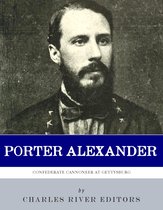Edward Porter Alexander at Gettysburg: His Letter to the Southern Historical Society Ebook Tooltip Ebooks kunnen worden gelezen op uw computer en op daarvoor geschikte e-readers.
Afbeeldingen
Artikel vergelijken
Auteur:
Edward Porter Alexander
- Engels
- E-book
- 9781619828629
- 24 januari 2012
- Adobe ePub
Samenvatting
In the narrative of the Civil War, Edward Porter Alexander has loomed larger in death than in life. Just 25 years old when the war broke out, Porter Alexander had already served as an engineer and officer in the U.S. Army, but the native Georgian resigned his commission in May 1861 and joined the Confederacy after his home state seceded. Porter Alexander spent 1861 as an intelligence officer, and he served as part of a signal guard, but he soon became chief of ordnance for Joseph Johnstons army near Richmond. Half a year later, Johnston would be injured during the Peninsula Campaign at the Battle of Seven Pines, after which he was replaced by Robert E. Lee. Over the course of 1862, Porter Alexander took on more roles in the Army of Northern Virginias artillery branch, particularly under Longstreets 1st Corps. Though he participated in several battles, he played his biggest role at the Battle of Gettysburg. On the third day, Lee decided to make a thrust at the center of the Unions line with about 15,000 men spread out over three divisions. Though it is now known as Picketts Charge, named after division commander George Pickett, the assignment for the charge was given to Longstreet, whose 1st Corps included Picketts division. Longstreet had serious misgivings about Lees plan and tried futilely to talk him out of it. Lees decision necessitated a heavy artillery bombardment of the Union line and attempting to knock out the Unions own artillery before beginning the charge that would cover nearly a mile of open space from Seminary Ridge to the Union line on Cemetery Ridge. Lee tasked Porter Alexander, in charge of the 1st Corps guns, to conduct the artillery bombardment. What resulted was the largest sustained bombardment of the Civil War, with over 150 Confederate cannons across the line firing incessantly at the Union line for nearly 2 hours. Unfortunately for Porter Alexander and the Confederates, the sheer number of cannons belched so much smoke that they had trouble gauging how effective the shells were. As it turned out, most of the artillery was overshooting the target, landing in the rear of the Union line. Reluctant to order the charge, Longstreet commanded Porter Alexander to order the timing for the charge. As Longstreet and Alexander anticipated, the charge was an utter disaster, incurring a nearly 50% casualty rate and failing to break the Union line. Porter Alexander would continue to serve under Longstreets corps for most of the rest of the war, and he famously suggested to Lee at Appomattox that the Confederate army should disband and melt away instead of surrender. Porter Alexander would later regret the suggestion, and Lee scolded him for it anyway.Though he had served with distinction during the Civil War, it was Porter Alexanders memoirs that have kept his name alive today. Though many prominent officers on both sides wrote memoirs, Porter Alexanders were among the most insightful and often considered by historians as the most evenhanded. With a sense of humor and a good narrative, Porter Alexander skillfully narrates the war, his service, and he isnt afraid to criticize officers, including Lee, when he thought they had made mistakes. As a result, historians continue to rely heavily on his memoirs as a source for Civil War history. Before he even wrote his memoirs, he wrote a letter in 1877 that was published in the Southern Historical Society, which kept a literary journal that helped develop the Lost Cause and became the clearinghouse for many Confederate writers after the war. In this letter, Porter Alexander narrates his account of Gettysburg. This edition of Edward Porter Alexander at Gettysburg is specially formatted with a Table of Contents and includes images of Porter Alexander and Gettysburg.
Productspecificaties
Wij vonden geen specificaties voor jouw zoekopdracht '{SEARCH}'.
Inhoud
- Taal
- en
- Bindwijze
- E-book
- Oorspronkelijke releasedatum
- 24 januari 2012
- Ebook Formaat
- Adobe ePub
Betrokkenen
- Hoofdauteur
- Edward Porter Alexander
- Hoofduitgeverij
- Charles River Editors
Lees mogelijkheden
- Lees dit ebook op
- Android (smartphone en tablet) | Kobo e-reader | Desktop (Mac en Windows) | iOS (smartphone en tablet) | Windows (smartphone en tablet)
Overige kenmerken
- Studieboek
- Nee
EAN
- EAN
- 9781619828629
Je vindt dit artikel in
Kies gewenste uitvoering
Bindwijze
: E-book
Prijsinformatie en bestellen
De prijs van dit product is 0 euro en 97 cent.
Direct beschikbaar
Verkoop door bol
- E-book is direct beschikbaar na aankoop
- E-books lezen is voordelig
- Dag en nacht klantenservice
- Veilig betalen
Houd er rekening mee dat je downloadartikelen niet kunt annuleren of retourneren. Bij nog niet verschenen producten kun je tot de verschijningsdatum annuleren.
Zie ook de retourvoorwaarden
Rapporteer dit artikel
Je wilt melding doen van illegale inhoud over dit artikel:
- Ik wil melding doen als klant
- Ik wil melding doen als autoriteit of trusted flagger
- Ik wil melding doen als partner
- Ik wil melding doen als merkhouder
Geen klant, autoriteit, trusted flagger, merkhouder of partner? Gebruik dan onderstaande link om melding te doen.








